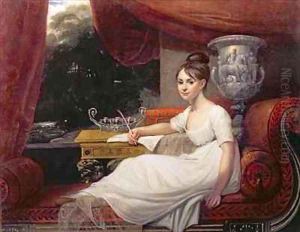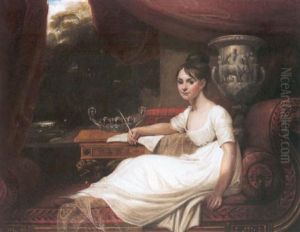Mary Ann Flaxman Paintings
Mary Ann Flaxman was an English artist and illustrator born in 1768. She was part of a family deeply involved in the arts, with her brother John Flaxman being a well-known sculptor and draughtsman who achieved considerable fame in England and in Europe. Mary Ann, sometimes overshadowed by her brother's success, developed her own artistic career, though less is known about her life and works compared to her brother.
Mary Ann Flaxman's artistic endeavors were encouraged in a period when the professional art world was largely male-dominated. Her works included illustrations and miniatures, and she worked on various commissions, often within the circle of her brother's influence. The siblings were part of a vibrant artistic community, and Mary Ann would have been exposed to the neoclassical aesthetics that were popular at the time, which heavily influenced her style.
One of the aspects of her work was contributing to illustrations for children's books, a genre that was gaining popularity at the time. Illustrations were becoming an increasingly important aspect of book production, and artists like Mary Ann Flaxman played a role in establishing the visual culture of printed materials for young audiences.
Despite her contributions, Mary Ann Flaxman remains a relatively obscure figure in art history. Many women artists of her time have not been given the same recognition as their male counterparts, and their works have often been overlooked or attributed to male artists. Today, art historians are working to rediscover and re-evaluate the contributions of women artists like Mary Ann Flaxman, acknowledging their rightful place in the history of art.
Mary Ann Flaxman passed away in 1833. While her legacy may not be as prominent as that of her brother, her life and work provide an important insight into the role of women in the arts during the late 18th and early 19th centuries. Her surviving works, though limited, continue to be subjects of interest for those studying women's history and the history of illustration.


